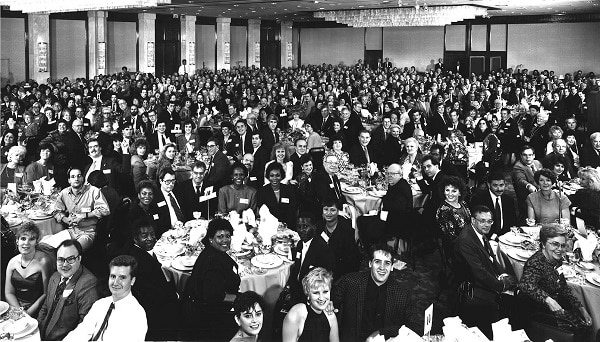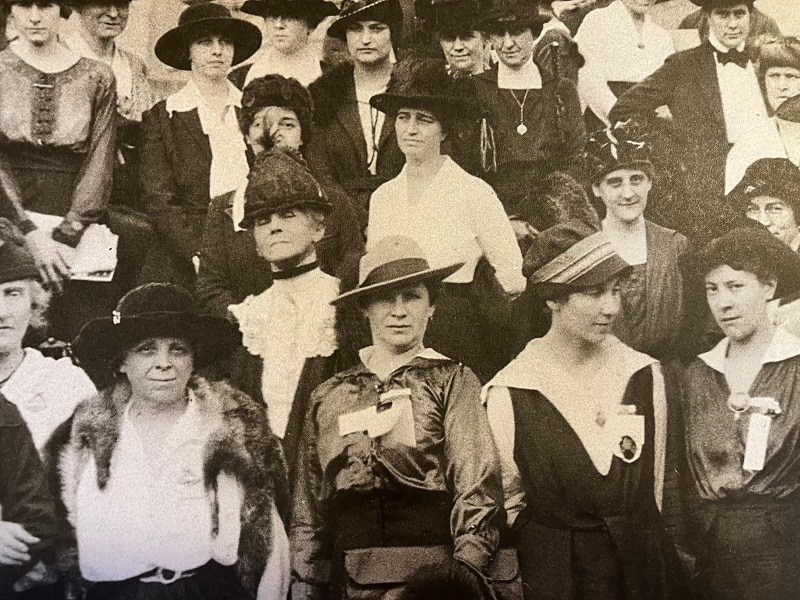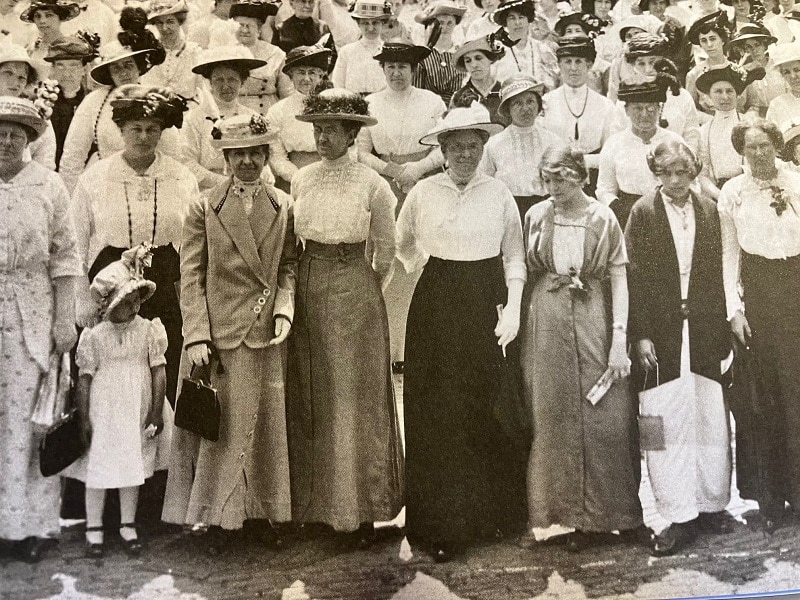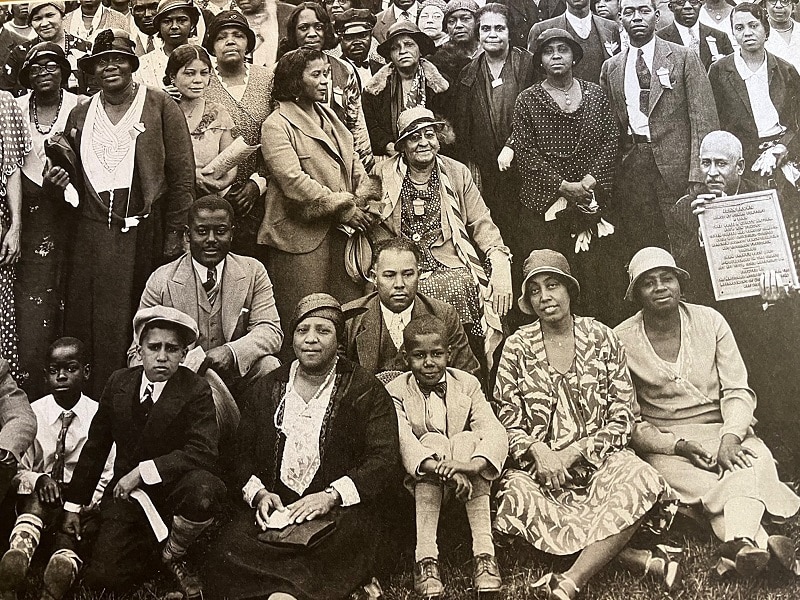Back on October 6, 1990, I was in a crowd of hundreds of people at a dinner in a downtown Chicago hotel for an event honoring the 100th anniversary of the renowned journalism boot-camp City News Bureau of Chicago where most of us had worked early in our careers.
At some point during the dinner, we were all instructed to quiet down and, from our tables, look toward a guy on a ladder who was pointing a camera at us. And, then, we got back to our conversations. I didn’t give it another thought.
But, a few years ago, I somehow came across the large-format panoramic photo that resulted from our mid-dinner pose.
It was on the first page of a six-page website that had been put up by CNB alum Thomas Yanul, the guy who took the photo and who had made a career out of taking such wide-angle, sharp-detail shots.

I found it striking and a bit startling that, even though the image took in all those hundreds of people in that hotel ballroom, I could find myself in very clear focus way, way at the back of the room. Here is that tiny portion of the big photo, showing three or four dozen people, including me and two friends, John Wolfe and Gordon Walek, nearby.

“Riches and contradictions”
Which is a roundabout way of saying that I came to Josh Sapan’s 2013 book The Big Picture with a bias.
In an Introduction, Lucy Sante, the noted writer on historic photographs and their meanings, calls the panoramic photo “a strange and compelling medium” which, although invented in Europe,
has always seemed like an especially American form of expression, uniquely adapted to the scale of the wide-open country of the late nineteenth and early twentieth centuries and its corresponding optimism and ambition.
She notes that Sapan’s book includes a broad array of subjects, such as one in which “a ragged cluster of students appear to have wandered into a study of the buildings of the Phillips Exeter campus and are trying to make up their minds what to do about it,” and a banquet-camera shot of the Sons of the Revolution at Delmonico’s.
And then there are a train wreck, a factory interior, an actor’s strike on Broadway (wonderfully cast as a sea of straw boaters), a number of bathing-beauty lineups, an array of motor homes, a spectacle at Coney Island, a gushing oil well, and a fire department. There are feminist gatherings, the NAACP, the Anti-Saloon League, labor unions, a peace conference, a seminary, a widows’ and orphans’ home, a judges’ shad bake, and a left-wing circus.
It is difficult if not impossible to imagine any of these pictures as having been taken anywhere but the United States, whose riches and contradictions they embody so nobly and gracefully.
“The faces in the photos”
Josh Sapan who put the collection together mentions in a Foreword that he has always been attracted to “the rather solemn whimsy so many panoramics present.”
He notes:
“We were here,” the faces in the photos seem to say, “and it mattered.”
That’s my bias: the faces in the photos.
A panoramic is, to my taste, well, too panoramic. It’s too big, too monumental, to take in. Unlike a regular photo which seems to mimic what the human eye sees, a panoramic takes in seemingly everything — much more than I am able to see in a given moment.
Sapan’s book is a very odd size, pretty much unshelvable in the usual way of shelves. Vertically, it’s 6.25 inches, or about the same as a run-of-the-mill paperback. But, horizontally, it runs 15.25 inches. That’s about as long as a 12-pack of Diet Pepsi cans.
The unusual format is necessary because panoramic photos are much longer than they are tall — 7 inches by 17 inches, or 12 inches by 20 inches. As it is, the images that appear in Sapan’s book are much smaller than their originals.
What’s missing is that wow-factor that happens when you hold a full-size panoramic in your hand. You’re overwhelmed by all the faces, each and every one sharp as a tack.
Not an about-to-be-photographed face
As I’ve said, it’s those individual faces that draw me into such a photo. Many of the images in The Big Picture have been reduced to such an extent that they don’t have the pop of the full-size version.
But Sapan has remedied this by providing, in several cases, a detail from the big picture, such as this detail from “The first International Congress of Working Women, called by the National Women’s Trade Union League of America — Washington, D.C., October 28, 1919.”

What’s fascinating for me about this detail — actually, the detail I’m presenting here is only part of a much wider image in Sapan’s book — is how the personalities of the women seem to jump out at the viewer.
I have a theory about this. The usual way things work is that a photographer asks a person to pose, and, in posing, the person puts on some about-to-be-photographed face and stance. The person might make a silly face or give a smile or put a hand on the hip or stare at the camera or away from the camera or any of myriad other things. The point is that a posing person generally isn’t acting normally, but instead responding to the event taking place.
The hundred or more women in this Congress of Working Women panoramic know they are having their photo taken, but they also know that they, as individuals, aren’t the subject. So, they’re not putting on an about-to-be-photographed face, but just standing there waiting for the process to be completed. No woman feels that she will be much more than a little splotch on the resultant photo.
But that’s the thing of panoramics. You can see each of these women almost secretly. For instance, the woman at the bottom right who is looking side-eyed at the camera — you feel that you have some sense of her personality. The same is true for the woman with the fur at the lower left with the fox-draped shoulder and large round hat and tired eyes.
And what does it mean that the woman second from the right on the bottom is looking away? What is she thinking? There are a couple women like that in the detail from “Ladies’ class at the First Christian Church of Canton Sunday school — Canton, Ohio, June 7, 1916.”

Here is a woman in a pretty dress who seems maybe sad (third from the right in the bottom row). She’s younger than most everyone else in the detail and hatless. Is that significant? She seems to be very far away in her thoughts.
And the woman to her left, also hatless and holding the strap of a small purse. She could be angry or maybe disturbed. Are the two hatless women connected in some way?
This detail is like a small novel with all of the characters lined up instead of listed at the front of the book.
Such humanity
Or imagine the novel that could be written with the people in this detail from “Pilgrimage of the twenty-third annual conference of the National Association for the Advancement of Colored People — Harpers Ferry, West Virginia, May 22, 1932.”

Such humanity. That’s what comes across in this detail, as, in fact, in all of the details in Sapan’s book. No one is putting on airs. Each person just is, caught in a moment in time, not “posing” but simply being.
The same can be said for this detail of “Office and factory staff of Fisher Body — Cleveland, Ohio, Date unknown.”

The panoramic must include the faces of at least a thousand men and maybe many more, but that mass of people falls away to nothing in contrast to this detail of some two or three dozen of those men.
Look at the guy in the second row with the big smile and the high pompadour, wearing overalls.
Let’s say he’s the main character in a story that also involves the short bald guy in the third row to the left with the thick moustache and the boyish looking guy at the other end of that row with his hand over the shoulder of as straight-arrow-looking a man as you’re every likely to find. And also the Jimmy Olsen-type guy in the front row with the bowtie.
Let’s make a movie with these guys as the characters. Maybe they’re part of a baseball team or an Army unit. And what of the dour-looking, high-forehead unsmiling guy you can see in the middle of that third row? Is he a victim or a victimizer?
That’s really the big picture in these big pictures — the humanity of the people whose images are captured as they pose when thinking they aren’t really posing.
The Big Picture is compelling in the ruminations it sets the mind to. But I have no idea how I’m going to put it on my bookshelves.
Patrick T. Reardon
4.11.23
Written by : Patrick T. Reardon
For more than three decades Patrick T. Reardon was an urban affairs writer, a feature writer, a columnist, and an editor for the Chicago Tribune. In 2000 he was one of a team of 50 staff members who won a Pulitzer Prize for explanatory reporting. Now a freelance writer and poet, he has contributed chapters to several books and is the author of Faith Stripped to Its Essence. His website is https://patricktreardon.com/.
